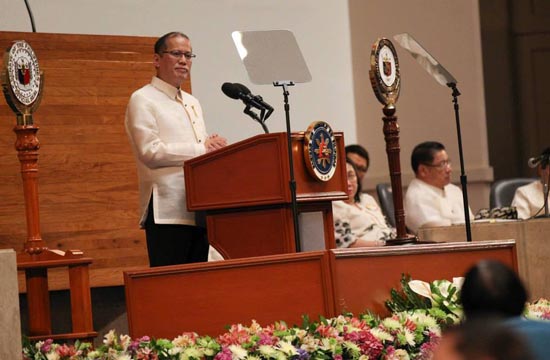Deceptive PPP claims in SONA
by Arnold Padilla, as originally posted at the Philippine Online Chronicles.
Infrastructure development through public-private partnership (PPP) was among the highlights of President Aquino’s fifth State of the Nation Address (SONA). Thanks to good governance, we no longer need to offer perks for investors to build our infrastructure needs, said the President. Thanks to good governance, the days of state-guaranteed private profits to entice PPP bidders are gone.
If the private sector wants to build our airport or highways, they must be willing to pay a premium, Aquino pointed out. The winning bidder in the Mactan-Cebu International Airport Passenger Terminal Building paid government P14 billion. The private contractor in the NAIA Expressway Project Phase 2 shelled out P11 billion.
But contrary to the SONA claims of Aquino, government continues to provide incentives to PPP investors. Some of these perks are even more generous than those offered by previous administrations. In addition, Aquino’s supposed “good governance” has nothing to do with investors paying a premium to bag PPP contracts. Their bidding decisions are always determined by how profitable or strategic the projects are.
Let us take a look again, for instance, at the P64.9-billion LRT Line 1 Extension and Operation and Maintenance project. This PPP contract will be awarded soon to Metro Pacific Investments Corp. (MPIC) and Ayala Corp. It is a sweetheart deal. Aquino would not just guarantee the debts of MPIC-Ayala; government is directly borrowing P34.9 billion or 54% of the project cost for right of way acquisition, additional coaches, etc. Government also agreed to shoulder the payment of real property taxes estimated at P64 billion throughout the life of the contract. These are on top of the P5-billion startup subsidy that government will provide. All in all, the direct cost to the government is almost P104 billion and just P30 billion to MPIC-Ayala. It becomes even more outrageous when you factor in the guaranteed profits that MPIC and Ayala will reap through automatic and periodic fare increases throughout the 32-year contract (which can be extended to up to 50 years). When MPIC-Ayala could not collect the agreed fares, government will again shell out public funds to cover the difference. Aquino called this regulatory risk guarantee, a government guarantee never before seen in the more than three-decade history of PPP and privatization in the Philippines. All these make the P9.5-billion premium that MPIC-Ayala promised to pay to clinch the concession meaningless.
Similarly, the Henry Sy-affiliated Megawide and its Indian partner GMR are building and operating the P17.52-billion Mactan-Cebu airport expansion because of its huge profit potential. The P14 billion that the consortium paid is peanuts compared to the windfall that the airport would make, which the Aquino administration guaranteed. Among the sweeteners of this PPP project is a 25-year government ban on the construction of other airports and related businesses in the Mactan and Cebu islands. There will also be a 25-year moratorium on the construction of any competing car park facility or any competing hotel facilities within the project’s 500-meter radius. Megawide-GMR will operate the country’s second busiest airport for 25 years, enjoying absolute monopoly over air passenger terminal and related services guaranteed throughout the concession agreement.
Meanwhile, in the case of the P15.52-billion NAIA expressway project, San Miguel Corp. (SMC) is charging P35-45 in toll rates. With traffic expected at 150,000 to 160,000 cars a day, that’s P1.92 to 2.63 billion in annual revenues. Its concession agreement with government is 30 years. This means that SMC is guaranteed to recover the project cost and premium in as short as 10 years, and then enjoy 20 years of raking profits. The recovery period could even be shortened by toll hikes and increased traffic volume. Note also that for SMC, the NAIA expressway has a more strategic value. The project will provide access to the NAIA terminals, which will benefit SMC’s air transport interests. The giant conglomerate of presidential uncle Danding Cojuangco controls 49% of the Philippine Airlines (PAL). It will also build a seamless link between SLEX/Skyway and the Manila-Cavite Toll Expressway. SMC, with Indonesian partner Citra, already controls SLEX/Skyway and the NAIA project will further consolidate its position in road transport in the area.
Local oligarchs and representatives of foreign interests in the country like the Ayala family, Henry Sy, Danding Cojuangco and his right-hand man Ramon Ang, or Manny V. Pangilinan (MVP) of MPIC participate in PPP not merely because they want to solve our infrastructure needs. As Jaime Augusto Zobel de Ayala put it: finding a private sector solution to the social problems of the country… must be oriented around a profit-centered solution. He was talking about private sector participation in mass housing for informal settlers. So, you see, there is a reason why these people are among the wealthiest in the world. In the 2014 Forbes’ list of richest Filipinos, Henry Sy and family recorded a net worth of $12 billion while Jaime Zobel de Ayala and family posted $3.1 billion; Danding, $825 million; Ramon Ang, $260 million; and MVP, $105 million.
PPP will continue to be the centerpiece program of Aquino in the remaining two years of his term. In his penultimate SONA, Aquino enumerated the top infrastructure priorities of his administration, most of which are controversial because of their social costs and impact. The P150-billion Laguna Lakeshore Expressway Dike, the P18.72-billion Kaliwa Dam, and Clark Green City, for example, are all feared to cause the massive displacement of local communities and the destruction of environment.
The same elite families and groups that have been bagging Aquino’s PPP contracts are positioning themselves to corner these deals. Despite public opposition, Aquino is determined to implement them, which could only further aggravate social tension and delegitimize his presidency even more.

